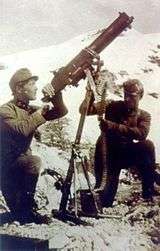Schwarzlose machine gun
The Maschinengewehr (Schwarzlose) M. 7, also known as the Schwarzlose MG, is a medium machine-gun, used as a standard issue firearm in the Austro-Hungarian Army throughout World War I. It was utilized by the Dutch, Greek and Hungarian armies during World War II. It was routinely issued to Italian colonial troops, alongside the Mannlicher M1895 rifle.[6]
| Maschinengewehr (Schwarzlose) M. 7 | |
|---|---|
 MG M.7/12 mounted on a wheel in a World War I-era anti-aircraft configuration. | |
| Type | Machine gun |
| Place of origin | Austria-Hungary |
| Service history | |
| In service | 1908–1945 (at least) |
| Used by | See Users |
| Wars | Balkan Wars World War I Russian Civil War[1] Austro-Slovene conflict in Carinthia Polish–Soviet War Greco-Turkish War (1919–22) Colombia–Peru War Austrian Civil War Spanish Civil War World War II 1948 Arab–Israeli War[2] |
| Production history | |
| Designer | Andreas Wilhelm Schwarzlose[3] |
| Designed | 1904[4] |
| Manufacturer | Steyr |
| Produced | 1908[5] – 1918 |
| Variants | See Variants |
| Specifications | |
| Mass | 41.4 kg (gun & tripod) |
| Length | 945 mm |
| Barrel length | 530 mm |
| Cartridge | 8×50mmR Mannlicher 8×56mmR 7.92×57mm Mauser 6.5×53mmR 6.5×55mm 7.62×54mmR .303 British |
| Action | Toggle-delayed blowback |
| Rate of fire | 400-580 round/min (M.7/12) 600-880 round/m (MG-16A) |
| Feed system | 250-round cloth belt |
History
The Schwarzlose M. 7 was a belt-fed machine gun, usually mounted on a tripod, designed by the Prussian firearms designer Andreas Schwarzlose. While its water-cooled barrel gave it an appearance broadly resembling the family of Maxim-derived machine-guns (such as the British Vickers and the German Maschinengewehr 08), internally the Schwarzlose was of a much simpler design, which made the weapon comparatively inexpensive to manufacture. Its unusual delayed blowback mechanism contained only a single spring. The initial variants of the M.7/12 had a cyclic rate of about 400 rounds/minute. During World War I this was increased to 580 rounds/minute by using a stronger mainspring. The Schwarzlose was robust and reliable, if used in its intended role as an infantry weapon. It met with less success when it was used in roles it had not been designed for, unlike the highly adaptable Maxim-derived machine guns.[7]
Production
The Schwarzlose enjoyed moderate export success in the years leading up to World War I. Apart from the armies of the Austro-Hungarian empire (8mm caliber) it was adopted by the armies of Greece (6.5mm caliber), the Netherlands (6.5mm caliber) and Sweden (using the 6.5×55mm cartridge and designated kulspruta m/1914).[8] In addition, the British ammunition company Kynoch produced a machine gun based on the Schwarzlose patent in 1907, using the .303 British cartridge.[9] The Netherlands used an modified version, the Schwarzlose M.08, in production from 1918 (2,006 made). After the First World War the Schwarzlose continued in use with the new nations that emerged from the fragments of the Austro-Hungarian empire. Captured examples of the Schwarzlose saw some sporadic use by Russian and Italian units during the First World War. During World War II the Schwarzlose saw limited action in North Africa as an anti-aircraft weapon in Italian service. It was also the standard MG issued to Italian colonial troops. Besides, captured Schwarzlose machine guns of various types saw service with second line units of the Nazi German army, especially during the desperate fighting that took place in the final phases of that conflict.[6]
Overview
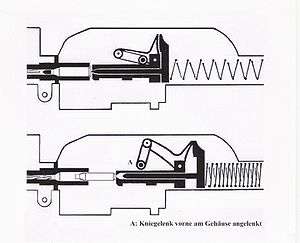
The Schwarzlose MG M.7 is a toggle-delayed blowback, water-cooled machine gun. The mechanism incorporates a device that oils cartridge cases to ease extraction.[10]
Use as an infantry and naval weapon
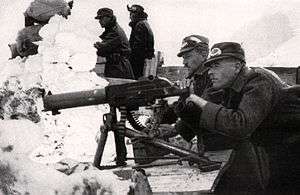
For infantry use, the Schwarzlose was usually employed as a traditional, tripod mounted, heavy machine gun served by a crew of at least three soldiers, one of whom was the commander, usually an NCO, a gunner who carried the weapon, a third soldier who served as an ammunition carrier and loader and he would presumably also carry the tripod although in practice a fourth soldier might be added to the team to carry the tripod. Another less commonly seen method of deployment was the more compact 'backpack mount'. In this configuration the gun was fitted with a backwards folding bipod attached to the front of the water jacket near the muzzle. The backpack mount itself consisted of a square wooden frame with a metal socket in the center. When the gun was fully deployed the frame was laid on the ground, the gun's central mounting point that usually attached to a tripod now had a small mounting pin attached to it instead which was inserted into the mounting socket in the center of the wooden backpack frame and finally the bipod was folded forward. The Schwarzlose would also have seen service as a fortress weapon in which case it would have been deployed on a variety of heavy and specialized fixed mountings and it also saw some use as a naval weapon aboard ship. During World War I the Schwarzlose was also pressed into service as an anti-aircraft gun and as such it was deployed using a variety of often improvised mountings.
Use as a fortification weapon
After World War I the Schwarzlose equipped the armed forces of Czechoslovakia, where it was adapted (vz. 7/24) and manufactured (vz. 24) as the těžký kulomet vz. 7/24 (heavy machine gun model 7/24) by the Janeček factory (adapted from 8 mm calibre to standard Czechoslovak munition 7,92 Mauser). When Czechoslovakia started building fortifications against Nazi Germany in 1935-1938, light fortifications, known as types 36 and 37, were partially armed with the Schwarzlose vz. 7/24.
Use as an aircraft gun
Apart from its use as a heavy infantry machine gun and as an anti-aircraft weapon, the Schwarzlose saw service with the Austro-Hungarian Luftfahrtruppe during World War I as an aircraft machine gun, a role for which it was not entirely suited. The Schwarzlose was used both as a fixed forward firing gun and as a flexible, ring mounted, defensive weapon.[6]
Synchronizing the Schwarzlose for use in fighters turned out to be a difficult engineering challenge. A critical factor in synchronization is the time delay between the trigger movement and the moment when the bullet leaves the barrel, as during this delay the propeller will continue to rotate, moving over an angle that also varies with engine rpm. Because of the relatively long delay time of the Schwarzlose M7/12, the synchronization systems that were developed could be operated safely only in a narrow band of engine rpm. Therefore, the Austro-Hungarian fighters were equipped with large and prominent tachometers in the cockpit. The M16 version of the gun could be synchronized with greater accuracy, but a widened engine rpm restriction still had to be respected, except for aircraft equipped with Daimler synchronization gear. The result was never entirely satisfactory and Austro-Hungarian aircraft thus armed usually carried the Kravics indicator to warn the pilot of a malfunction in the synchronization gear. The Kravics propeller hit indicator consisted of electric wiring wrapped around the critical area of the propeller blades, connected to a light in the cockpit by a slip ring on the propeller shaft. If the light went out, the pilot knew the propeller had been hit.,[11]
Until these synchronization problems had been overcome, it was not uncommon to see the Schwarzlose deployed in a removable forward firing Type-II VK gun container which had been developed by the Luftfahrtruppe's Versuchs Kompanie at Fischamend. The Type-II VK, which received the macabre nickname 'baby coffin' due to its shape, is remarkable in that it was possibly the first example of what today would be called a gun pod.[12] It was usually mounted on the centerline of the upper wing of Austro-Hungarian fighters and two-seat combat aircraft during the early phases of World War I and remained in use on two-seat combat aircraft until the end of the war. In its role as an aircraft weapon the Schwarzlose was initially used unmodified — other than that, the distinctive cone shaped flash-hider seen on most of the infantry weapons was removed. The Schwarzlose was further modified for aircraft use, much as the German Empire's own lMG 08 Spandau ordnance had been modified early in 1915, by cutting slots into the water jacket's sheetmetal to facilitate air cooling. In 1916 the water jacket was removed entirely and the resulting weapon was re-designated as the Schwarzlose MG-16 and MG-16A when fitted with a stronger spring and a blowback enhancer to increase the guns cyclic rate which was eventually brought up to 880 rounds per minute in some versions of the MG-16A. As a defensive ring mounted gun the Schwarzlose usually retained its normal twin firing handles and trigger button although some MG-16 aircraft guns were fitted with enlarged pistol shaped handles and a handgun style trigger. All ring mounted defensive guns were equipped with specialized sights and a box for the ammunition belt which allowed quick and trouble-free reloading. After the end of World War I the Schwarzlose saw limited use as an aircraft gun with various East European air forces. The best known post war operator of the Schwarzlose was probably the Polish air force who acquired and used significant numbers of surplus Austro-Hungarian aircraft and used them against Soviet forces during the Polish-Bolshevik War. The Schwarzlose was, however, quickly phased out of service as an aircraft weapon when more suitable equipment became available.[13]
Variants
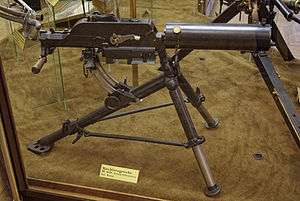
Austro-Hungarian
- MG M.7, MG M.7/12, MG-16, MG-16A in 8×50mmR Mannlicher.
British
- Kynoch Machine Gun was manufactured by the Kynoch ammunition company, presumably in .303 British,[9]
Czechoslovak
- Schwarzlose-Janeček vz.07/24: The M.7/12 Machine Gun was modified by inventor František Janeček. Modifications include: rechambering to 7.92×57 mm Mauser, a lighter bolt, shorter recoil spring and extension of the barrel by 100 mm. Manufacture and adaptation of these guns took place in the Zbrojovka Brno factory. During 1922 and 1934 there were 4937 modified Schwarzlose M.7/12 MGs to vz.7/24 and 2253 newly produced vz.24 MGs.[14]
Hungarian
- MG M.07/31 converted from original 8×50mmR Mannlicher to 8×56mmR.[16] Same as their Mannlicher M1895 rifles.
Users
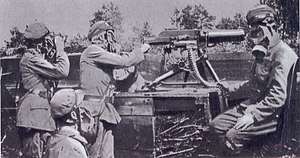
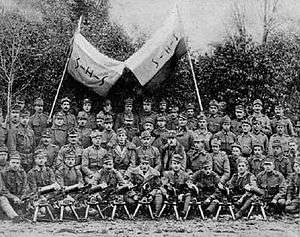


.svg.png)






.svg.png)
.svg.png)
.svg.png)
_crowned.svg.png)


.svg.png)



.svg.png)
.svg.png)

.svg.png)
.svg.png)
- Used by Jewish partisans during the 1947–48 Civil War in Mandatory Palestine.
References
- Notes
- "Vintage Saturday: Assorted Machine Guns". Forgotten Weapons. 18 October 2014.
- "The Birth of Israel". Anyathor007 (YouTube). 18 August 2012. Retrieved 12 December 2015.
- Peterson 2007, p. 31
- https://patents.google.com/patent/US863101A
- Ortner 2011, p. 214
- Willbanks 2004, p. 57
- Peterson 2013, p. 34
- The Swedish machineguns before 1950. Text and pictures by O. Janson
- "Kynoch Machine Gun". Forgotten Weapons. 19 December 2011. Retrieved 11 December 2015.
- Hatcher 1947, pp. 38–44
- Williams, Anthony G. "Synchronisation systems" (PDF). Quarryhs.
based on Flying Guns: World War I and Flying Guns: World War II by Anthony G Williams and Emmanuel Gustin
- Woodman 1989, p. ?
- Chant 2002, p. 89
- http://www.rotanazdar.cz/?p=3411
- Smith 1969, p. 211.
- Smith 1969, p. 459.
- "Machine Guns, part 2". 4 November 2017.
- 火器堂 - 四川機器局
- Jowett, Philip (28 June 2018). Latin American Wars 1900–1941: "Banana Wars," Border Wars & Revolutions. Men-at-Arms 519. Osprey Publishing. p. 36. ISBN 9781472826282.
- "Czechoslovakia" (PDF). Armaments year-book : general and statistical information. Series of League of Nations publications. IX, Disarmament. 1926.IX.1. Geneva: League of Nations. 1926. p. 339.
- Lugosi, József (2008). "Gyalogsági fegyverek 1868–2008". In Lugosi, József; Markó, György (eds.). Hazánk dicsőségére: 160 éves a Magyar Honvédség. Budapest: Zrínyi Kiadó. p. 382. ISBN 978-963-327-461-3.
- Smith 1969, p. 490.
- Lohnstein, Marc (23 August 2018). Royal Netherlands East Indies Army 1936–42. Men-at-Arms 521. pp. 12, 21. ISBN 9781472833754.
- Nowakowski, Tomasz (2014). "Śmiercionośne narzędzie I wojny światowej - karabin maszynowy Schwarzlose M. 07/12". Poligon (in Polish) (3(44)/2014): 15–17.
- Smith 1969, p. 535.
- Peterson 2007, p. 286
- Mark Axworthy, London: Arms and Armour, 1995, Third Axis, Fourth Ally: Romanian Armed Forces in the European War, 1941–1945, p. 29
- «в течение осени и зимы 1915 года… своих винтовок царской армии уже недоставало. Многие солдаты, в частности, весь наш полк, имели на вооружении трофейные австрийские винтовки, благо патронов к ним было больше, чем к нашим. По той же причине наряду с пулемётами "Максим" сплошь и рядом в царской армии можно было встретить австрийский "Шварцлозе"»
А. М. Василевский. Дело всей жизни. 7-е изд. кн. 1. М., 1990. стр.21-22 - de Quesada, Alejandro (20 January 2015). The Spanish Civil War 1936–39 (2): Republican Forces. Men-at-Arms 498. Osprey Publishing. p. 38. ISBN 9781782007852.
- Smith 1969, p. 723.
- Sources
- Chant, Christopher (2002). A Century of Triumph: The History of Aviation. New York: Simon and Schuster. ISBN 978-0-7432-3479-5.
- Hatcher, Julian (1947). Hatcher's Notebook. The Military Service Press Company. ISBN 0-8117-0795-4.
- Ortner, M. Christian (2011). Storm Troops. Verlag Militaria. ISBN 978-3-9501642-8-2.
- Peterson, Phillip (24 September 2007). Standard Catalog of Military Firearms: The Collector's Price and Reference Guide. Gun Digest Books. ISBN 1-4402-3046-3.
- Peterson, Phillip (18 October 2013). Standard Catalog of Military Firearms: The Collector's Price and Reference Guide. Iola, Wisconsin: Krause Publications. ISBN 978-1-4402-3692-1.
- Smith, Joseph E. (1969). Small Arms of the World (11 ed.). Harrisburg, Pennsylvania: The Stackpole Company.CS1 maint: ref=harv (link)
- Willbanks, James H. (1 January 2004). Machine Guns: An Illustrated History of Their Impact. ABC-CLIO. ISBN 978-1-85109-480-6.
- Woodman, Harry (1989). Early Aircraft Armament. Weidenfeld Military. ISBN 0-85368-990-3.
- "Instruktion [...] Maschinengewehr (Schwarzlose) M. 7" (PDF). Wien: k. k. Hof- und Staatsdruckerei. 1913 [1908]. Cite journal requires
|journal=(help)
External links
| Wikimedia Commons has media related to Schwarzlose MG. |
- The Schwarzlose machine gun photogallery (probably czech heavy machine gun model 7/24)
- Austro-Hungarian Machine Guns - Schwarzlose
- The Schwarzlose in Swedish service
- "The Vintage Aviator's" page on the Schwarzlose aircraft gun
- YouTube animation showing mechanism of Schwarzlose machine gun
- "Firing the Schwarzlose Machine Gun". MidWestMetal (YouTube). 4 December 2009.
- "Schwarzlose M1907/12 Heavy Machine Gun at James D Julia". Forgotten Weapons (YouTube). 2 March 2015. - Explanation of how the gun works.
